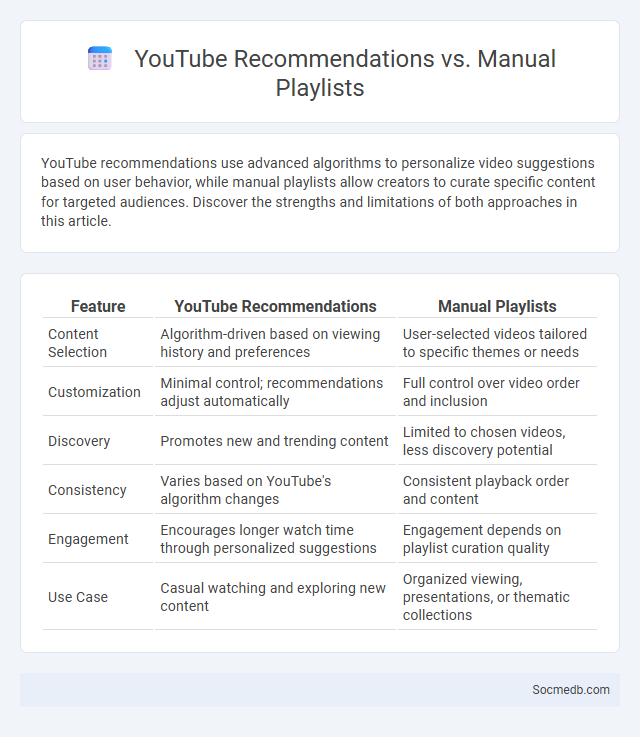
Photo illustration: YouTube Recommendations vs Manual Playlists
YouTube recommendations use advanced algorithms to personalize video suggestions based on user behavior, while manual playlists allow creators to curate specific content for targeted audiences. Discover the strengths and limitations of both approaches in this article.
Table of Comparison
| Feature | YouTube Recommendations | Manual Playlists |
|---|---|---|
| Content Selection | Algorithm-driven based on viewing history and preferences | User-selected videos tailored to specific themes or needs |
| Customization | Minimal control; recommendations adjust automatically | Full control over video order and inclusion |
| Discovery | Promotes new and trending content | Limited to chosen videos, less discovery potential |
| Consistency | Varies based on YouTube's algorithm changes | Consistent playback order and content |
| Engagement | Encourages longer watch time through personalized suggestions | Engagement depends on playlist curation quality |
| Use Case | Casual watching and exploring new content | Organized viewing, presentations, or thematic collections |
Understanding YouTube’s Recommendation System
YouTube's recommendation system uses machine learning algorithms to analyze your viewing history, engagement patterns, and video metadata to suggest personalized content that matches your interests. The system prioritizes videos with high watch time, viewer retention, and engagement metrics to keep you on the platform longer. Understanding this process helps you optimize your content strategy to increase visibility and audience growth on YouTube.
What Are Manual Playlists?
Manual playlists on social media platforms are user-curated collections of audio or video content, allowing individuals to organize media based on personal preferences or themes. These playlists enable users to selectively add, remove, or reorder tracks or clips, enhancing content discovery and engagement. Platforms like YouTube, Spotify, and TikTok support manual playlists, boosting user interaction by tailoring media consumption experiences.
How YouTube Recommendations Work
YouTube recommendations rely on advanced machine learning algorithms that analyze your viewing history, search queries, and engagement patterns to personalize content suggestions. The platform evaluates video metadata, user interactions, and watch time to predict which videos will keep you engaged longer. Understanding this system can help you optimize your content for better visibility and audience growth.
Advantages of Manual Playlists
Manual playlists give you complete control over song selection and order, ensuring a personalized listening experience tailored to your unique taste. They allow precise curation that algorithms can't replicate, enhancing engagement and mood management. This hands-on approach supports creativity and fosters stronger connections with your social media audience by showcasing your authentic preferences.
Limitations of Algorithmic Recommendations
Algorithmic recommendations on social media platforms often create echo chambers by reinforcing users' existing preferences, limiting exposure to diverse perspectives. These algorithms prioritize engagement metrics such as clicks and watch time, which can amplify sensational or misleading content over factual information. User privacy concerns also arise as these systems rely on extensive personal data collection to tailor recommendations.
User Control vs Algorithmic Discovery
User control on social media empowers individuals to curate their content feeds through manual selection, enhancing personal relevance and satisfaction. Algorithmic discovery leverages machine learning models to analyze user behavior and preferences, delivering personalized content that can increase engagement and time spent on the platform. Balancing user control with algorithmic curation is critical to optimize user experience while avoiding filter bubbles and promoting diverse content exposure.
Content Diversity: Playlists vs Recommendations
Content diversity in social media enhances your experience by offering both playlists and personalized recommendations tailored to your interests. Playlists provide a curated, structured sequence of content chosen by creators or algorithms, ensuring thematic consistency. Recommendations adapt dynamically based on your interactions, promoting discovery of new topics and expanding your digital horizons.
Personalization in YouTube Playlists
YouTube playlists leverage advanced algorithms to enhance personalization by analyzing user behavior, preferences, and watch history. These tailored playlists improve viewer engagement by curating content that aligns with individual interests, increasing watch time and user satisfaction. Machine learning models continuously refine recommendations, making YouTube a leading platform for customized video experiences.
Engagement Impact: Recommendations vs Playlists
Recommendations on social media platforms generate higher user engagement by offering personalized content tailored to individual preferences, leading to increased time spent and interaction rates. Playlists, while popular for organizing content, often result in more passive consumption with lower active engagement metrics such as comments and shares. Optimizing algorithms to prioritize dynamic, user-specific recommendations significantly boosts overall platform engagement and user retention.
Choosing the Best Approach for Your Viewing Experience
Selecting the best approach for your social media viewing experience depends on factors like content preferences, platform algorithms, and privacy settings. Tailoring your feed by following specific accounts and engaging actively with content enhances relevance and enjoyment. Utilizing platform features such as customized notifications and content filters further optimizes the balance between entertainment and information.
 socmedb.com
socmedb.com